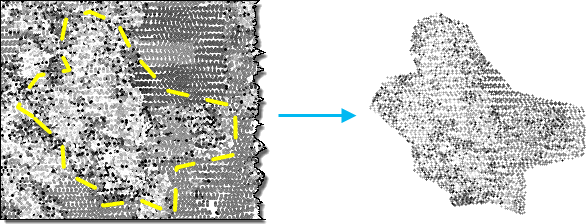| Label | Explanation | Data Type |
Input Point Cloud | The LAS dataset, point cloud scene layer package (.slpk file), or I3S point cloud service that will be extracted. An I3S point cloud service must have the export property enabled to be processed. | LAS Dataset Layer; Scene Layer; File |
Target Folder
| The existing folder where the output .las files will be written. | Folder |
Processing Extent (Optional) | The extent of the data that will be evaluated.
When coordinates are manually provided, the coordinates must be numeric values and in the active map's coordinate system. The map may use different display units than the provided coordinates. Use a negative value sign for south and west coordinates. | Extent |
Extraction Boundary
(Optional) | A polygon boundary that will be used to clip the input point cloud. This boundary should represent a primary study area that is typically defined by one contiguous polygon, but it can also be composed of more than one polygon when it represents a common study area with a relevant spatial gap. | Feature Layer |
Process entire LAS files that intersect extent
(Optional) | Specifies how the area of interest will be used in determining how .las files will be processed. The area of interest is defined by the Processing Extent parameter value, the Processing Boundary parameter value, or a combination of both.
| Boolean |
Output File Name Suffix (Optional) | The text that will be appended to the name of each output .las file. Each file will inherit its base name from its source file, followed by the suffix provided in this parameter. | String |
Remove Variable Length Records
(Optional) | Specifies whether variable length records (VLRs) will be removed. Each .las file may contain a set of VLRs that were added by the software that produced it. The meaning of these records is typically only known by the originating software. Unless the output LAS data will be processed by an application that understands this information, retaining the VLRs may not provide any value-added functionality. Removing the VLRs may save significant disk space depending on their total size and the number of files containing them.
| Boolean |
Rearrange points (Optional) | Specifies whether points in the .las or .zlas files will be rearranged to optimize the performance of reading and updating the classification of the point cloud.
| Boolean |
Compute Statistics (Optional) | Specifies whether statistics will be computed for the .las files referenced by the LAS dataset. Computing statistics provides a spatial index for each .las file, which improves analysis and display performance. Statistics also enhance the filtering and symbology experience by limiting the display of LAS attributes, such as classification codes and return information, to values that are present in the .las file.
| Boolean |
Output LAS Dataset
(Optional) | The output LAS dataset referencing the newly created .las files. | LAS Dataset |
Compression
(Optional) | Specifies whether the output .las file will be in a compressed format or the standard LAS format.
| String |
Derived Output
| Label | Explanation | Data Type |
| Output Folder | The folder where the .las files will be written. | Folder |

 —The extent will be based on the active map or scene.
—The extent will be based on the active map or scene. —The extent will be based on a rectangle drawn on the map or scene.
—The extent will be based on a rectangle drawn on the map or scene. —The extent will be based on an active map layer. Choose an available layer or use the
—The extent will be based on an active map layer. Choose an available layer or use the  —The extent of all features.
—The extent of all features. —The extent of the selected features.
—The extent of the selected features. —The extent of visible features.
—The extent of visible features. —The extent will be based on a dataset.
—The extent will be based on a dataset. —The extent will be the intersecting extent of all inputs.
—The extent will be the intersecting extent of all inputs. —The extent will be the combined extent of all inputs.
—The extent will be the combined extent of all inputs. —The extent can be copied to and from the clipboard.
—The extent can be copied to and from the clipboard. —Copies the extent and coordinate
system to the clipboard.
—Copies the extent and coordinate
system to the clipboard. —The extent will be reset to the default value.
—The extent will be reset to the default value.